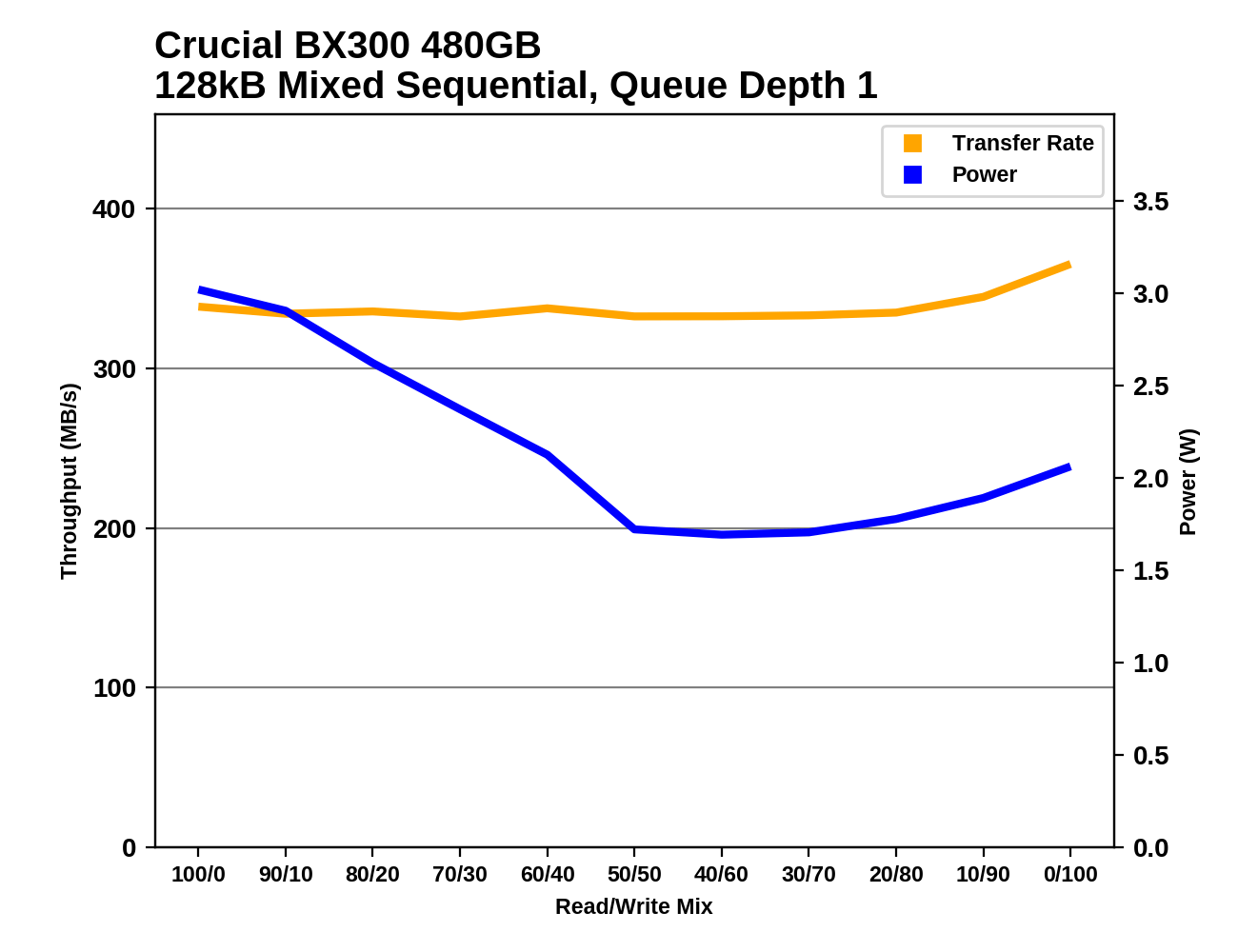The Crucial BX300 (480GB) SSD Review: Back To MLC
by Billy Tallis on August 29, 2017 9:00 AM ESTMixed Random Performance
Our test of mixed random reads and writes covers mixes varying from pure reads to pure writes at 10% increments. Each mix is tested for up to 1 minute or 32GB of data transferred. The test is conducted with a queue depth of 4, and is limited to a 64GB span of the drive. In between each mix, the drive is given idle time of up to one minute so that the overall duty cycle is 50%.

The mixed random I/O performance if the Crucial BX300 puts it in the second tier of SATA SSDs, with Samsung's 850s forming the top tier. The Crucial MX300 is a bit slower than the BX300.

With the exception of the Crucial MX200, all of the drives that outperformed the BX300 are also more efficient. The MX300 is also significantly more efficient despite being slightly slower.
 |
|||||||||
The Crucial BX300's performance on the mixed random I/O test increases slowly as the proportion of writes grows, and it accelerates near the end of the test. The power consumption is flat across almost all of the test, but ticks up as the workload shifts to pure writes.
Samsung's drives are faster than the BX300 across the entire test, while the Intel 545s and Crucial MX200 managed higher average performance scores by performing better on the read-heavy portions of the test and a bit worse during the write-heavy phases.
Mixed Sequential Performance
Our test of mixed sequential reads and writes differs from the mixed random I/O test by performing 128kB sequential accesses rather than 4kB accesses at random locations, and the sequential test is conducted at queue depth 1. The range of mixes tested is the same, and the timing and limits on data transfers are also the same as above.

The Crucial BX300 performs very well on the mixed sequential I/O test, slightly ahead of the Samsung 850 EVO and only 5% slower than the 850 PRO. The MX300 scores closer to the middle of the pack, while the BX200 and MX200 are near the bottom.

The Crucial BX300's power efficiency score isn't quite as close to the top score, but only because Toshiba's OCZ VX500 really stands out from the crowd. The BX300 is ahead of the Samsung 850 PRO and close to the 850 EVO, MX300, and Intel 545s.
 |
|||||||||
The BX300's performance doesn't change much over the course of the mixed sequental test, but it does speed up a bit near the end. Power consumption starts out high but drops dramatically across the first half of the test, and then follows the shape of the performance curve.










90 Comments
View All Comments
BrokenCrayons - Wednesday, August 30, 2017 - link
You're right, I don't know every aspect of every engineering problem that exists. You don't either and, on a much smaller scale, you probably didn't read my comment closely enough to understand every aspect of it before you mistakenly assumed I'd adopted a particular viewpoint. If you read closely, you'll see we're attempting to make the same point.Alexvrb - Wednesday, August 30, 2017 - link
If you agree that you'll never burn out a 3D TLC equipped drive, then they are both effectively equal on that front. If the MLC-equipped drives are worse performing, you've paid the same for a slower product. I think it might be more reasonable to ask why anyone would bother with a product which is saddled with an inferior controller just because it has a sticker than says "MLC!!!!oneone1eleven".BrokenCrayons - Wednesday, August 30, 2017 - link
Well, I hate to sink your ship, but they're not worse performing. :)plopke - Tuesday, August 29, 2017 - link
thats the thing, it is priced cheap enough, if you are a enthusiast , you might have a M.2 PCIe4 drive , but I could see myself adding a BX300 to expand storage. It just looks like great bang for buck not?MajGenRelativity - Tuesday, August 29, 2017 - link
It does seem like it is priced wellAlexvrb - Wednesday, August 30, 2017 - link
Except at 1TB-2TB range. Then the ADATA SU900 and MX300 are worth a look. Especially if you're using it for secondary storage only.Lolimaster - Tuesday, August 29, 2017 - link
NVME basically offers you higher max transfer which helps when working/and or moving huge files.What most people actually complain about TLC is sustained transfers when the SLC cache depletes.
bug77 - Wednesday, August 30, 2017 - link
Motherboards have a lot more SATA connectors than they have NVMe. That may have something to do with it.doylecc - Friday, November 3, 2017 - link
Ever heard of RAID??? It is frequently less expensive to use two or three inexpensive SATA SSDs in RAID 0 to achieve transfer rates comparable to the very expensive NVME drives. Most motherboards only have one M.2 slot, so you can't RAID the NVME M.2s. Older motherboards that lack an M.2 slot can still support SATA RAID setups.On an older AMD motherboard, the SATA controller maxed out with 3 SSDs in RAID 0 (over 1200 MB/S). When I added a fourth SSD, performance actually declined in some tests, so I figure the controller was saturated.
ImSpartacus - Tuesday, August 29, 2017 - link
Did I miss the performance consistency section? I always like that.